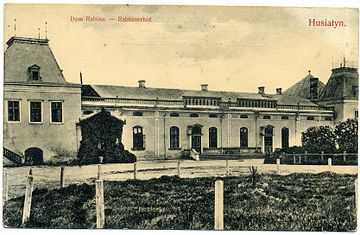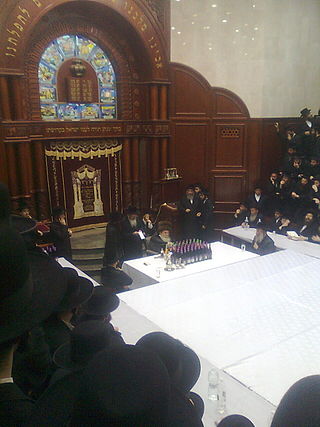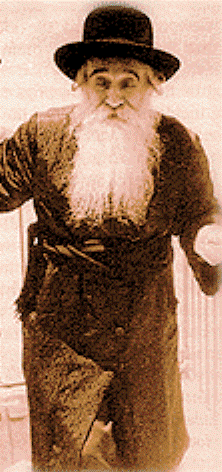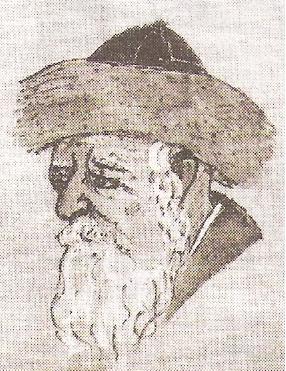
Husiatyn is the name of a Hasidic dynasty, whose founder was a scion of the Ruzhiner dynasty. Husiatyn is located in present-day Ukraine.

Husiatyn is the name of a Hasidic dynasty, whose founder was a scion of the Ruzhiner dynasty. Husiatyn is located in present-day Ukraine.
It started with the Rebbe Rabbi Mordechai Shraga Feivish Friedman, the youngest son of Rabbi Israel Friedmann of Rizhin. Reb Mordechai Shraga Feivish was only 16 when his father died and when he turned 30 in 1865, he moved to Husiatyn where he established a large Hasidic court. He died during the spring of 1894 and was succeeded by his son Reb Yisroel who took over the position of rebbe in Husiatyn until 1912. At the outbreak of World War I, he together with other Rebbes of Rizhin moved to Vienna, subsequently settling there. From time to time he made trips to visit his chassidim that remained in Galicia.
The Admorim of Rizhin were known for their love of the Land of Israel, and Reb Yisroel's feelings were especially deep. The Husiatyn Rebbe was very pro yishuv ha'aretz, settling the land with frum Jews, in order to have influence over secular Jews settling the land. He wanted to exert a more Torah and Jewish influence to a very secular Zionism.
When one of the rebbes of Rizhin died, plans were made to establish a Rizhin section in the Jewish cemetery in Vienna. The rebbe of Husiatyn stated that there would be no need to take him into account as he proposed to emigrate to Eretz Israel. And so it was, during the 1930s, Reb Yisroel made plans to make aliyah. He traveled around Europe to bid farewell to his followers and warn them of the impending danger. He urged them to make aliyah and leave Europe.
As a result of the increased anti-Semitism he had witnessed, himself being a victim of stone throwers in a Viennese street, he had visions of what was to befall the Jewish people in the years to come. In Kraków he was reported to have instructed: "Whoever has some sense should flee while he can - even in his slippers!" To the Jews who came to the train station in Lwów to greet him he said: "Whoever can sell his property should do so, and those who are unable to sell should leave everything and flee from here, even if only with a sack on his back!"
In 1937 the rebbe docked at Haifa and settled in Tel Aviv. Aged 80 and the only surviving grandson of the Rizhiner Rebbe, he was considered the "elder" of the rebbes of Rizhin. During the summer months he would reside in Jerusalem until the 3rd of cheshvan, the yartzeit of his grandfather. On that day he would visit the Western Wall and go to pray at the grave of the holy Ohr Hachaim on the Mount of Olives.
He led his Hasidim for over 50 years until he died in Tel Aviv aged 92. In his will he requested to be buried on the Mount of Olives and if that was not possible, in Safad or Tiberias. When he died on the fifth day of Hanukkah 1949, the Mount of Olives in Jerusalem was inaccessible being under Jordanian control. As he died on a Friday there was also not enough time to organise a plot in the ancient Jewish cemetery in Safed. He was therefore buried in Tiberias amongst the students of the Baal Shem Tov.
His son-in-law, Rabbi Yaakov Freidman, a son of the Bohusher Rebbe, Rabbi Yitzchok Friedman, was appointed as the new leader. He continued the dynasty until his death in 1957 when his son Reb Yitzchok took over. When Reb Yitzchok died in 1968, the Husiatyn dynasty ended. Today the Husiatyn Beth midrash on Bialik Street, Tel Aviv, continues to be used for prayer and study.
| |||||||||||||||||||||||||||||||||||||||||||||||||||||||||||||||||||||||||||||||||||||||||||||||||||||||||||||||||||||||||||||||||||||||||||||||||||||||||||||||||||||||||||||||||||||||||||||||||||||||||||||||||||||||||||||||||||||||||||||||||||||||||||||||||||||||||||||||||||||||||||||||||||||||||||||||||||||||||||||||||||||||||||||||||||||||||||||||||||||||||||||||||||||||||||||||||||||||||||||||||||||||||||||||||||||||||||||||||||||||||||||||||||||||||||||||||||||||||||||||||||||||||||||||||||||||||||||||||||||||||||||||||||||||||||||||||||||||||||||||||||||||||||||||||||||||||||||||||||||||||||||||||||||||||||||||||||||||||||||||||||||||||||||||||||||||||||||||||||||||||||||||||||||||||||||||||||||||||||||||||||||||||||||||||||||||||||||||||||||||||||||||||||||||||||||||||||||||||||||||||||||||||||||||||||||||||||||||||||||||||||||||||||||||||||||||||||||||||||||||||||||||||||||||||||||||||||||||||||||||||||||||||||||||||||||||||||||||||||||||||||||||||||||||||||||||||||||||||||||||

Vizhnitz is the name of a Hasidic dynasty founded by Rabbi Menachem Mendel Hager. Vizhnitz is the Yiddish name of Vyzhnytsia, a town in present-day Ukraine.

Skver is a Chasidic dynasty founded by Rebbe Yitzchok Twersky in the city of Skver, or Skvyra, in present-day Ukraine during the mid-19th century. Adherents of the rebbes of Skver are known as Skverer Hasidim.

Aleksander is a Polish Hasidic dynasty originating from the city of Aleksandrow Lodzki, Poland, where it was founded by Grand Rabbi Yechiel Denciger (1828–1894). Aleksander is a branch of Vurka, as Shraga Fayvel Danciger was a leading disciple of Rabbi Israel Yitzhak Kalish of Vurka. Prior to the Holocaust, Aleksander was the second to largest Hasidic group in Poland. They attracted artisans, merchants and water carriers rather than elite Talmudic scholars and richer people who were attracted to Ger. Like the rest of Polish Jewry, almost all of Aleksander hasidim were murdered in the Holocaust. Between the world wars, Hasidic Jews from all over flocked to the small village of Aleksander to spend the holiest days of the Jewish year in the presence of their spiritual leader, their rebbe, Rabbi Yitzchak Menachem Danciger (1879–1942). The Rebbe of Aleksander attempted to remain neutral in political issues while emphasizing communal prayer and the study of Torah. He was murdered by the Germans on September 5, 1942, eight days before Rosh Hashana, at Treblinka extermination camp. Today, Aleksander has emerged from the ashes of the Holocaust and continues growing in numbers in small communities in America, Europe and Israel.

Chernobyl is a Hasidic dynasty that was founded by Grand Rabbi Menachem Nachum Twersky, known by the name of his work as the Meor Einayim. The dynasty is named after the northern Ukrainian town of Chernobyl, where Rabbi Nachum served as the maggid. The lineage has continued to exist to this day, although not always with the name Chernobyl. Today there are several rebbes named Chernobyl. The central court is in Bnei Brak, headed by Rabbi Menachem Nachum Twersky.

Chortkov is a Hasidic dynasty that originated in Chortkiv, present-day Ukraine. The town was part of the Tarnopol Voivodeship of the Second Polish Republic until September 1939. The town itself was founded in 1522 by Polish King Sigismund I the Old. The dynasty had a large following before the Second World War, but most of its adherents were murdered in the Holocaust.

Ruzhin is the name of a Hasidic dynasty founded by Rabbi Yisroel Friedman (1796–1850) in the town of Ruzhyn, Ukraine, today an urban-type settlement in Zhytomyr Oblast, Ukraine.

Boston is a Hasidic dynasty, originally established in 1915 by Rabbi Pinchas David Horowitz, a scion of the Nikolsburg Hasidic dynasty. Following the custom of European Chassidic Courts, where the Rebbe was called after the name of his city, the Bostoner branch of Hasidic Judaism was named after Boston, Massachusetts. The most senior and well-known of the Bostoner Rebbes in contemporary times was Grand Rabbi Levi Yitzchak Horowitz, who died in December 2009.
Zvhil is the name of a Hasidic dynasty, with adherents today in Jerusalem, Boston, and New York.
Boyan is a Hasidic dynasty named after the town of Boiany in the historic region of Bukovina, now in Ukraine. The Hasidut is headquartered in Jerusalem, with communities in Beitar Ilit, Bnei Brak, Manchester, Australia, Beit Shemesh, London, Antwerp, Manhattan, Brooklyn, Los Angeles, Monsey, Lakewood, and Atlanta. Boyan is one of the branches of the Ruzhiner dynasty, together with Bohush, Chortkov, Husiatyn, Sadigura, Kapishnitz, Vaslui and Shtefanesht.

Sadigura is a Hasidic dynasty named for the city of Sadhora, Bukovina, which belonged to Austria. The dynasty began in 1850 with Rabbi Avrohom Yaakov Friedman, a son of Rabbi Yisrael Friedman of Ruzhyn, and was based in Sadigura until 1914. During the interwar period the dynasty was led by Rebbes in Vienna and Przemyśl, Poland, and on the eve of World War II was transplanted to Israel, where it thrives to this day.
Bohush is a Hasidic dynasty named for the town of Buhuși, Romania. The dynasty began in the mid-nineteenth century with Rabbi Yitzchok Friedman of Bohush, the eldest grandson of Rabbi Yisrael Friedman of Ruzhyn, and was based in that town until 1951, when his great-grandson, Rabbi Yitzchok Friedman of Bohush-Tel Aviv, moved the dynasty to Tel Aviv. In 1987 the Bohush beis medrash was transferred to Bnei Brak, where the dynasty is led today by Rabbi Yaakov Mendel Friedman, a great-great-grandson of the first Bohusher Rebbe.

Mezhbizh is the name of the town of Medzhybizh in the present Ukraine which is significant as both the source of a Hasidic dynasty that bears its name and as a symbolic name for the roots of Hasidism.

Shtefanesht was a Hasidic dynasty named for the town of Ștefănești, Romania. It was one of the branches of the Ruzhiner dynasty, together with Bohush, Boyan, Chortkov, Husiatyn, and Sadigura. The dynasty lasted from 1851 to 1933 and had only two Rebbes: Rabbi Menachem Nochum Friedman, a son of the Ruzhiner Rebbe, and Rabbi Avrohom Mattisyohu Friedman, the only son of Rabbi Menachem Nochum. During the latter's reign, Ștefănești became one of the most important Hasidic centers in Eastern Europe.

Vasloi was a Hasidic dynasty centered in Vaslui, Romania, and founded by Rabbi Shalom Halpern, a grandson of Rabbi Yisroel Friedman of Ruzhyn in the Russian Empire.

Nachum Dov Brayer is the Rebbe of the Boyan Hasidic dynasty. He is the grandson of the former Boyaner Rebbe of New York, Rabbi Mordechai Shlomo Friedman. On Hanukkah 1984, at the age of 25, he was crowned Boyaner Rebbe. He lives in Jerusalem.

Mordechai Shlomo Friedman, sometimes called Solomon Mordecai Friedman, was the Boyaner Rebbe of New York for over 40 years. In 1927 he left Europe to become one of the first Hasidic Rebbes in America, establishing his court on the Lower East Side of New York City and attracting many American Jewish youth with his charismatic and warm personality. He also played a role in American Jewish leadership with positions on Agudath Israel of America, the Moetzes Gedolei HaTorah, and Holocaust rescue organizations. In 1957 he built the flagship Ruzhiner yeshiva, Tiferet Yisroel, at the top of Malkhei Yisrael Street in Jerusalem.
Koidanov is a Hasidic dynasty originating from the city of Dzyarzhynsk (Koidanov), Belarus, where it was founded by Rabbi Shlomo Chaim Perlow in 1833. Koidanov is a branch of both Lechovitch Hasidism and Karlin-Stolin Hasidism as Rabbi Shlomo Chaim Perlow was the paternal grandson of Rabbi Mordechai of Lechovitch and the maternal grandson of Rabbi Asher of Stolin. Koidanov was the smallest of the three Lithuanian Hasidic dynasties, with most of its Hasidim being murdered in the Holocaust. The dynasty was re-established after the war in Tel Aviv, then moved to Bnei Brak, where the majority of the dynasty is located, but there are Chassidim located around the world.

Avrohom Yaakov Friedman was the first Rebbe of the Sadigura Hasidic dynasty. He lived in the palatial home constructed by his father, Rabbi Yisrael Friedman of Ruzhyn, who fled to the Austrian town of Sadhora due to persecution by the Russian Tsar. He maintained his father's extravagant lifestyle while immersing himself in Torah study and mysticism. He was considered the greatest Rebbe of his era, attracting hundreds of thousands of Jews as well as prominent Christian leaders to his court.
Avrohom Yaakov Friedman, in English also spelled Abraham Jacob Friedman was the third Rebbe of the Sadigura Hasidic dynasty. He was a prominent Jewish leader in Vienna in the interwar period and in the nascent State of Israel, where he established his court in Tel Aviv. He was one of the first members of Agudat Israel and occupied a seat on the Moetzes Gedolei HaTorah.

Avrohom Yaakov Friedman was the fifth Rebbe of the Sadigura Hasidic dynasty. In 1979 he succeeded his father, the fourth Sadigura Rebbe, and took his seat on the Moetzes Gedolei HaTorah. He oversaw the growth of Sadigura communities in Israel and in London, Antwerp, and New York City.